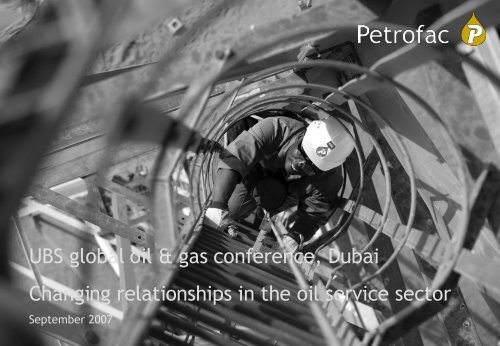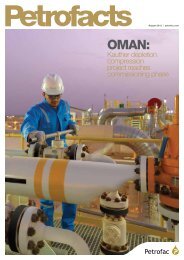Download PDF - Petrofac
Download PDF - Petrofac
Download PDF - Petrofac
Create successful ePaper yourself
Turn your PDF publications into a flip-book with our unique Google optimized e-Paper software.
UBS global oil & gas conference, Dubai<br />
Changing relationships in the oil service sector<br />
September 2007
Agenda<br />
2. <strong>Petrofac</strong>: a brief introduction<br />
3. Development of the oil service sector<br />
4. New partnership models<br />
5. <strong>Petrofac</strong>’s positioning<br />
2
1. <strong>Petrofac</strong>: a brief introduction<br />
<strong>Petrofac</strong> is a leading international provider of facilities solutions to the oil & gas<br />
production and processing industry<br />
We provide project development, engineering, construction and facilities operation,<br />
maintenance and training services; we also invest alongside our clients, delivering<br />
our engineering and operations services service capability in complete alignment<br />
Our clients include many of the world’s leading integrated, independent and<br />
national oil and gas companies<br />
Revenue Net profit Backlog<br />
391<br />
629<br />
952<br />
1,864<br />
48% CAGR 37% CAGR 47% CAGR<br />
1,485<br />
2002 2003 2004 2005 2006<br />
Note: all figures presented above are for the group’s continuing operations (US$ millions)<br />
34.3<br />
38.4<br />
46.1<br />
75.4<br />
121.9<br />
2002 2003 2004 2005 2006<br />
885<br />
1,097<br />
1,740<br />
3,244<br />
4,173<br />
2002 2003 2004 2005 2006<br />
3
1. <strong>Petrofac</strong>: a brief introduction<br />
Our core geographic focus is on the Middle East, North Africa, the UK Continental<br />
Shelf, the Commonwealth of Independent States and the Asia Pacific region<br />
<strong>Petrofac</strong> operates out of four strategically located international centres, in<br />
Aberdeen, Sharjah, Woking and Mumbai and a further 16 offices worldwide :<br />
Houston<br />
Woking<br />
Algiers<br />
Aberdeen<br />
Lagos<br />
London<br />
Damascus<br />
Baku<br />
Ahmadi<br />
Doha<br />
Abu Dhabi<br />
Khartoum<br />
Moscow<br />
Tehran<br />
Sharjah<br />
We are a people business, with over 9,500 employees<br />
Tunis<br />
Bishkek<br />
Mumbai<br />
Kuala Lumpar<br />
Delivering world class competency with local resources and with strong focus on HSE<br />
Chennai<br />
4
1. <strong>Petrofac</strong>: a brief introduction<br />
<strong>Petrofac</strong> designs and builds oil & gas facilities; operates and manages facilities<br />
and trains personnel; and, where it can leverage its service capability, develops<br />
and co-invests<br />
5
2. Development of the oil service sector<br />
The upstream oil & gas industry has four categories of major “actors” -<br />
and their inter-relationships are changing:<br />
Integrated Major Oil Companies (IOCs)<br />
Increasingly focusing on long-term, multi-billion-$ opportunities where<br />
national oil companies are daunted by scale &/or technical complexity<br />
Finding access to conventional oil in conventional regions is more<br />
challenging<br />
National Oil Companies (NOCs)<br />
Increasingly asserting their power, dis-intermediating IOCs - both where<br />
NOCs have ready access to international finance and where they do not<br />
Independent Oil Companies<br />
Generally niche exploration, and less commonly, mature-asset focused<br />
Service companies<br />
Finding, therefore, that the customer-base is shifting<br />
6
2. Development of the oil service sector: 1960s<br />
Integrated oil: the traditional model<br />
Large oil companies, horizontally integrated, broad skill-set<br />
Upstream Downstream<br />
Geology and<br />
Geophysics<br />
Prospect<br />
Generation<br />
Exploration<br />
Drilling<br />
Engineering<br />
Development<br />
Service Sector<br />
Operation and<br />
Maintenance<br />
Specialist<br />
Maintenance<br />
Well Services<br />
Refining and<br />
Product Sales<br />
7
2. Development of the oil service sector: by 1990<br />
Geology and<br />
Geophysics<br />
Prospect<br />
Generation<br />
Outsourcing begins to transform the industry<br />
Upstream Downstream<br />
Exploration<br />
Drilling<br />
Engineering<br />
Development<br />
Service Sector<br />
Operation and<br />
Maintenance<br />
Specialist<br />
Maintenance<br />
Well Services<br />
Refining and<br />
Product Sales<br />
8
2. Development of the oil service sector: 2000s<br />
Integrated<br />
Niche/<br />
Equity<br />
Geology and<br />
Geophysics<br />
Specialisation and the emergence of new business models:<br />
Prospect<br />
Generation<br />
Exploration<br />
Drilling<br />
Engineering<br />
Operation and<br />
Maintenance<br />
Refining and<br />
Product Sales<br />
More capable service companies, increased integration of services<br />
Development<br />
Service Sector<br />
Specialist<br />
Maintenance<br />
Well Services<br />
9
3. New partnership models<br />
Pre-OPEC 1, IOCs had access to equity oil throughout the world; power was based<br />
on access to technology, capital and integrative capability; relatively limited<br />
alignment of interests between IOC and NOC<br />
Production Sharing Contract (PSC) model shifted balance of power in direction of<br />
NOCs - and somewhat improved IOC/NOC alignment<br />
Even in a PSC, alignment is in question, particularly as fields become mature and<br />
returns more marginal:<br />
− Tax-take is the point of friction<br />
− Pressure has increased for sovereign governments/NOCs not to ‘sign away’<br />
reserves<br />
− The wealthier NOCs do not require IOC capital and are reluctant to pay high<br />
returns for it<br />
− IOCs want to book oil & gas reserves and are focused on reserve replacement<br />
− NOCs are primarily interested in capability, now less dependent on IOCs than<br />
pre-OPEC 1<br />
Thus there has been a growing trend for the disintermediation of the IOC<br />
10
4. <strong>Petrofac</strong>’s positioning<br />
Tunisia, ETAP<br />
Algeria, Sonatrach<br />
Kuwait, Kuwait Oil Company UAE, Dubai Petroleum<br />
Oman, Ministry of Oil & Gas and PDO<br />
Our relationships with NOCs encompass the provision of both our<br />
engineering and operations service capabilities and as development<br />
partner through Energy Developments<br />
Malaysia, Petronas<br />
11
4. <strong>Petrofac</strong>’s positioning<br />
Kuwait Oil Company, Kuwait<br />
5 year full maintenance services contract, including<br />
provision of management and technical support team<br />
and systems<br />
Preventative, corrective and predictive maintenance<br />
execution using 650 maintenance personnel<br />
General services including site accommodation and<br />
catering services<br />
Major overhauls on rotating equipment<br />
Site workshops<br />
Reimbursable materials<br />
Measured extra works (Brownfield Engineering)<br />
Training of company’s personnel (nationalisation)<br />
Engineering services and spare parts for control and<br />
shutdown systems<br />
In addition, <strong>Petrofac</strong> is also undertaking a US$680m<br />
lump-sum facilities upgrade project for KOC<br />
12
4. <strong>Petrofac</strong>’s positioning<br />
Dubai Petroleum, UAE<br />
Service operator contract for the provision of well and<br />
facilities management services for all offshore oil &<br />
gas assets<br />
Assets comprise four offshore fields, 70 platforms, 400<br />
wells, approximately 600 full-time employees and 500<br />
contractors<br />
Full operating responsibility transferred to <strong>Petrofac</strong> in<br />
April 2007<br />
Alignment through profit sharing of upside<br />
Material increase in scale for <strong>Petrofac</strong>’s international<br />
Operations Services business<br />
13
4. <strong>Petrofac</strong>’s positioning<br />
Why Dubai Petroleum is important<br />
First time a government entity has chosen to exploit its hydrocarbon resources<br />
through direct contracting with an international service provider<br />
Dubai gets the capability it requires without relinquishing reserves or control of<br />
reserves<br />
Though the fields are mature, because they were initially quite large,<br />
considerable potential remains<br />
In contrast to most UKCS mature-field examples therefore, there are major<br />
developments planned alongside the rejuvenation of the mature operation itself<br />
For <strong>Petrofac</strong> - a reputation-making opportunity<br />
14
4. <strong>Petrofac</strong>’s positioning<br />
Early days yet, but…<br />
As expected, the inherited organisation itself - its attitude to business - bore the<br />
imprint of more than 35 years of “business as usual”<br />
Many opportunities for short-term production increase have been identified, and<br />
some already secured<br />
The economics are different pre- and post-changeover: governments are looking<br />
at “100% economics” and this makes a lot more investment opportunities<br />
attractive<br />
We have demonstrated that the risks of transfer of operatorship - the area of<br />
most concern to any resource owner contemplating change - are manageable<br />
This transition activity has been carried out by <strong>Petrofac</strong> many times in UK but<br />
never before in an international context with an international workforce<br />
The ability to do this - and particularly, the track record of having done it so<br />
many times - is a key <strong>Petrofac</strong> differentiator<br />
15
4. <strong>Petrofac</strong>’s positioning<br />
Where next?<br />
Not all governments are as action-oriented as Dubai - so complete replication<br />
will not be easy<br />
This example however - and others where service companies are extending the<br />
boundaries of previous service provision - are beginning to catch the attention of<br />
some more forward-thinking NOCs<br />
We know that many NOC-operated operations where IOCs have largely been<br />
absent for decades are inefficient; considerable scope exists for efficiency<br />
improvement leading to increased productivity<br />
It is possible that other regional players will conduct experiments in ring-fenced<br />
areas in the use of turn-key service provision<br />
Against this theoretical opportunity has to be set the conservatism and the “old-<br />
think” contractor relationship attitudes still prevalent in many NOCs<br />
16
Appendix 1: <strong>Petrofac</strong>’s positioning, examples<br />
ETAP, Tunisia<br />
Chergui gas field<br />
<strong>Petrofac</strong> owns a 45% interest in the Chergui gas<br />
concession from ETAP for a cash consideration of<br />
approximately US$30m; ETAP hold 55% interest<br />
Commencement of production from the field is expected<br />
early 2008, with plateau rates expected to be maintained<br />
for around four years with a further eight years of<br />
operation beyond that<br />
Hasdrubal gas plant<br />
US$400m lump-sum turnkey contract for BG Group and<br />
Entreprise Tunisienne d’Activites Petrolieres (ETAP)<br />
Scope includes: project management, detailed design,<br />
procurement, construction, pre-commissioning and startup<br />
performance testing of the new gas plant processing<br />
facility and the liquefied petroleum gas production<br />
facility<br />
17
Appendix 1: <strong>Petrofac</strong>’s positioning, examples<br />
Petronas, Malaysia<br />
Cendor PM304 field undeveloped for years but with<br />
proven reserves estimated at 24.6m barrels<br />
<strong>Petrofac</strong> is operator with a 30% interest; partners are<br />
Petronas Carigali, Kuwait Foreign Petroleum<br />
Exploration Company and PetroVietnam Investment<br />
Development Company<br />
<strong>Petrofac</strong>’s full range of capabilities, Engineering &<br />
Construction, Operations Services and asset<br />
management, deployed to provide optimal solution<br />
Asset management focus on developing innovative<br />
solutions for smaller fields<br />
From farm-in to full production in less than two years,<br />
ahead of the prescribed timetable and below budget<br />
First oil achieved in September 2006; daily production<br />
approximately 14,000 barrels<br />
18
Appendix 1: <strong>Petrofac</strong>’s positioning, examples<br />
Ministry of Oil & Gas and PDO, Oman<br />
Harweel development cluster, PDO<br />
Turnkey project value approximately US$1 billion<br />
Scope includes: project management, detailed<br />
engineering, procurement, construction and precommissioning<br />
Training and support during commissioning of the<br />
project<br />
Kauther gas plant, Ministry of Oil & Gas<br />
US$246m lump-sum engineering, procurement and<br />
construction project with (initial) one-year operation<br />
Will draw capability across the <strong>Petrofac</strong> Group from<br />
Engineering & Construction to Operation Services<br />
19
Appendix 1: <strong>Petrofac</strong>’s positioning, examples<br />
Sonatrach, Algeria<br />
Ohanet is a large gas field development located in<br />
Illizi province<br />
Risk Services Contract (RSC) with Sonatrach; partners<br />
are BHP Billiton (Operator), Japan Ohanet Oil & Gas<br />
Co and Woodside Energy<br />
Average daily production is approximately 14.6 million<br />
m 3 /d gas, 24,240 bpd condensate, 2,770 tonnes per<br />
day LPG<br />
<strong>Petrofac</strong> investment US$100 million; US$1 billion total<br />
project value<br />
Pioneered the partnership business model<br />
First time non-recourse financing used in Algeria<br />
20
UBS global oil & gas conference, Dubai<br />
Changing relationships in the oil service sector<br />
September 2007



